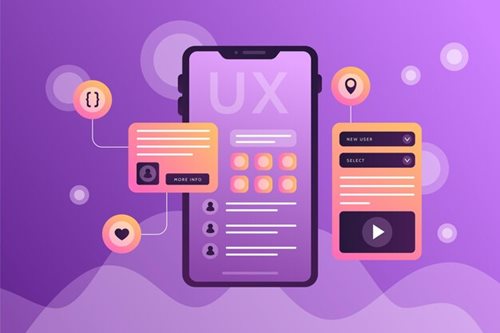Get your free consultation today!
Share with your Colleagues
Categories
ROI Calculator
Moonstone Interactive is the only San Francisco Bay Area web design firm and Internet Marketing expert that offers a free online ROI Calculator
Author: Steve Herz

In today's digital landscape, exceptional user experiences (UX) are paramount for engaging and retaining users. This introduction explores the intricate world of UX design, shedding light on innovative strategies that elevate user interaction and satisfaction. Through a blend of theory and practical examples, we embark on a deep dive into how these UX strategies can transform digital products into intuitive and delightful experiences. Uncover the secrets behind crafting digital environments that resonate deeply with users, fostering loyalty and driving success.
Understanding the Foundations: What's UI/UX?
The distinction between User Interface (UI) and User Experience (UX) is fundamental to the digital design. A graphical user interface is the visual gateway through which users interact with your digital product, encompassing everything from buttons and text to images and sliders. However, understanding what UI/UX is goes beyond recognizing these elements. UI is about creating a visually appealing and functional interface, whereas UX is about the overall feel and effectiveness of the interaction with the digital product. Together, they ensure that a product is attractive, intuitive, and satisfying, laying the groundwork for a successful digital experience.
The Difference Between UI and UX
- Visual and Functional Harmony: UI, or User Interface design, is akin to visual storytelling elements like stage design, costumes, and lighting. These elements capture the audience's attention and make an initial impression. In the digital world, this translates to the layout, color schemes, button styles, and typography used on a website or application.
- UI Elements:
- Layouts and spatial organization
- Color schemes and visual themes
- Button designs and interactive elements
- Typography and iconography
- Aesthetic Appeal: Ensures the product is visually appealing and aligns with brand identity.
- UI Elements:
- UX, or User Experience design, on the other hand, is about the script, direction, and performance flow. It focuses on the user's journey through the application or website, ensuring that this journey is intuitive, efficient, and satisfying.
- UX Elements:
- Navigation structure and ease of finding information
- Interaction design and response to user actions
- Information architecture and content prioritization
- User feedback and problem-solving pathways
- Emotional Engagement: Creates a connection with the user by making their experience seamless and intuitive.
- UX Elements:
- Integration of UI and UX: The most effective digital products seamlessly integrate UI and UX, ensuring that the visual elements (UI) enhance the user journey (UX) rather than detract from it. This integration is crucial for creating products that are not only beautiful but also highly functional and user-friendly.
- Collaborative Effort: Involves continuous collaboration between UI designers, who focus on the visual aspects, and UX designers, who ensure the functionality and flow are user-centered.
- User Testing: Regularly testing with actual users to gather feedback on UI and UX elements, allowing for iterative improvements that enhance the overall user experience.
Understanding the distinct roles and interplay of UI and UX is essential for anyone creating digital products. It's not just about making something look good (UI) but also about making it work well (UX). This symbiotic relationship is what creates a truly captivating and effective digital experience.
Benefits of UX Design
- Increased Conversion Rates: A well-crafted UX design directly contributes to higher conversion rates. Users are more likely to purchase or sign up for a service by making the user journey intuitive and enjoyable.
- Simplified Pathways: Reducing the steps needed to complete an action.
- Clear Calls-to-Action: Making it obvious what the user should do next.
- Enhanced Customer Retention: Positive user experiences lead to higher levels of customer satisfaction, increasing customer loyalty and retention. A user who finds a website or app easy and pleasant to use is more likely to return.
- Personalization: Tailoring experiences to individual user preferences.
- Feedback Loops: Incorporating user feedback to improve the UX continually.
- Reduced Development Costs: By identifying potential issues and user needs early in the design process, UX design can significantly reduce the need for costly redesigns and revisions after launch.
- Prototyping and User Testing: Early and ongoing testing to catch and correct issues before they become expensive problems.
- Efficient Design Process: Streamlining the development process by focusing on user needs from the outset.
- Competitive Advantage: A superior UX can be a key differentiator in a crowded marketplace. The subtleties of the user experience often set similar products apart and sway user preference.
- Brand Perception: A positive user experience enhances the brand's overall perception.
- Market Positioning: Standing out through superior usability and user satisfaction.
Investing in UX design enhances the user interface; it's about strategically improving every aspect of the user's interaction with the product. This holistic approach to design and development benefits the user and contributes significantly to the business's success.
Demystifying the Terms: What UI Means and Web UI Meaning
When we delve into what UI means, we focus on the components users interact with on digital platforms. The term web UI narrows this focus to the context of websites and online applications, highlighting the importance of visual elements like layout, color schemes, typography, and interactive elements that make web navigation intuitive and engaging. A well-designed web UI makes a website visually appealing and enhances its usability, making it easier for users to find the information they need and take desired actions. This clarity in design and purpose is crucial for creating positive first impressions and fostering user satisfaction.
Crafting Exceptional Experiences: UX Strategies
Effective UX strategies are the cornerstone of creating digital products that users love. Implementing these strategies involves a multi-faceted approach:
- Personalization: Customize the user experience based on individual behaviors and past interactions. Personalization can increase engagement and satisfaction by making users feel understood and valued.
- Simplicity: Aim for a clean and straightforward design that facilitates ease of use. A clutter-free interface can significantly enhance users' ability to navigate and enjoy your product.
- Feedback: Provide immediate and clear feedback for user actions. Addressing this feedback can help make the interaction more responsive and engaging, building trust between the user and the product.
- Accessibility: Design your product to be usable by people with a wide range of abilities. Accessibility expands your user base and demonstrates a commitment to inclusivity.
- Testing: Continuously test your product and service with real users to identify areas for improvement. User feedback is invaluable for refining UX and optimizing your product for the user's needs and expectations.
In conclusion, the journey to crafting exceptional user experiences is ongoing and ever-evolving. By understanding and applying the principles of UI and UX design, focusing on UX conversion optimization, and continuously seeking to improve website UX, we can create digital products that stand out in a crowded marketplace. Remember, at the heart of every great digital product is a commitment to delivering an unparalleled user experience. Let's make that our mission - get in touch with us!


